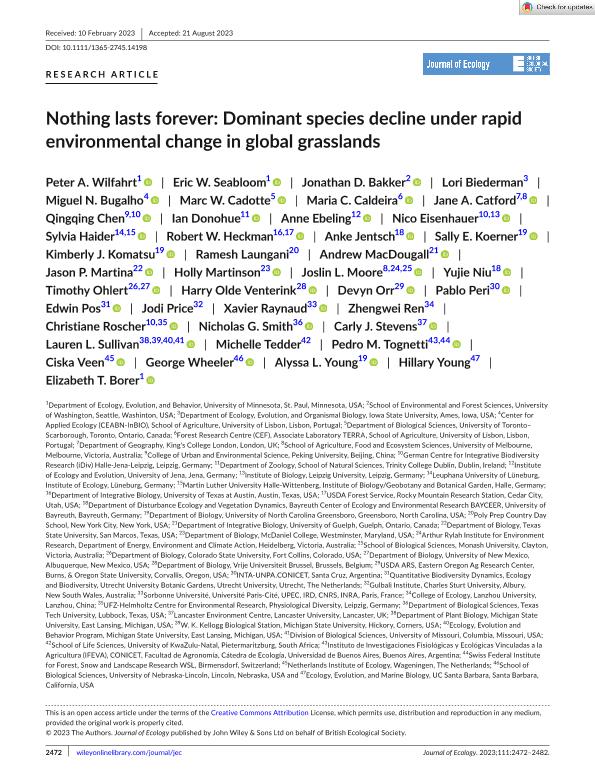Artículo
Nothing lasts forever: Dominant species decline under rapid environmental change in global grasslands
Wilfahrt, Peter A.; Seabloom, Eric; Bakker, Jonathan; Biederman, Lori; Bugalho, Miguel N.; Cadotte, Marc W.; Caldeira, Maria C.; Catford, Jane A.; Chen, Qingqing; Donohue, Ian; Ebeling, Anne; Eisenhauer, Nico; Haider, Sylvia; Heckman, Robert W.; Jentsch, Anke; Koerner, Sally E.; Komatsu, Kimberly J.; Laungani, Ramesh; MacDougall, Andrew; Smith, Nicholas G.; Stevens, Carly J.; Sullivan, Lauren L.; Tedder, Michelle; Peri, Pablo Luis ; Tognetti, Pedro Maximiliano
; Tognetti, Pedro Maximiliano ; Veen, Ciska; Wheeler, George; Young, Alyssa L.; Young, Hillary; Borer, Elizabeth
; Veen, Ciska; Wheeler, George; Young, Alyssa L.; Young, Hillary; Borer, Elizabeth
 ; Tognetti, Pedro Maximiliano
; Tognetti, Pedro Maximiliano ; Veen, Ciska; Wheeler, George; Young, Alyssa L.; Young, Hillary; Borer, Elizabeth
; Veen, Ciska; Wheeler, George; Young, Alyssa L.; Young, Hillary; Borer, Elizabeth
Fecha de publicación:
11/2023
Editorial:
Wiley Blackwell Publishing, Inc
Revista:
Journal of Ecology
ISSN:
0022-0477
Idioma:
Inglés
Tipo de recurso:
Artículo publicado
Clasificación temática:
Resumen
Dominance often indicates one or a few species being best suited for resource capture and retention in a given environment. Press perturbations that change availability of limiting resources can restructure competitive hierarchies, allowing new species to capture or retain resources and leaving once dominant species fated to decline. However, dominant species may maintain high abundances even when their new environments no longer favour them due to stochastic processes associated with their high abundance, impeding deterministic processes that would otherwise diminish them. Here, we quantify the persistence of dominance by tracking the rate of decline in dominant species at 90 globally distributed grassland sites under experimentally elevated soil nutrient supply and reduced vertebrate consumer pressure. We found that chronic experimental nutrient addition and vertebrate exclusion caused certain subsets of species to lose dominance more quickly than in control plots. In control plots, perennial species and species with high initial cover maintained dominance for longer than annual species and those with low initial cover respectively. In fertilized plots, species with high initial cover maintained dominance at similar rates to control plots, while those with lower initial cover lost dominance even faster than similar species in controls. High initial cover increased the estimated time to dominance loss more strongly in plots with vertebrate exclosures than in controls. Vertebrate exclosures caused a slight decrease in the persistence of dominance for perennials, while fertilization brought perennials' rate of dominance loss in line with those of annuals. Annual species lost dominance at similar rates regardless of treatments. Synthesis. Collectively, these results point to a strong role of a species' historical abundance in maintaining dominance following environmental perturbations. Because dominant species play an outsized role in driving ecosystem processes, their ability to remain dominant—regardless of environmental conditions—is critical to anticipating expected rates of change in the structure and function of grasslands. Species that maintain dominance while no longer competitively favoured following press perturbations due to their historical abundances may result in community compositions that do not maximize resource capture, a key process of system responses to global change.
Archivos asociados
Licencia
Identificadores
Colecciones
Articulos(SEDE CENTRAL)
Articulos de SEDE CENTRAL
Articulos de SEDE CENTRAL
Citación
Wilfahrt, Peter A.; Seabloom, Eric; Bakker, Jonathan; Biederman, Lori; Bugalho, Miguel N.; et al.; Nothing lasts forever: Dominant species decline under rapid environmental change in global grasslands; Wiley Blackwell Publishing, Inc; Journal of Ecology; 111; 11; 11-2023; 2472-2482
Compartir
Altmétricas



